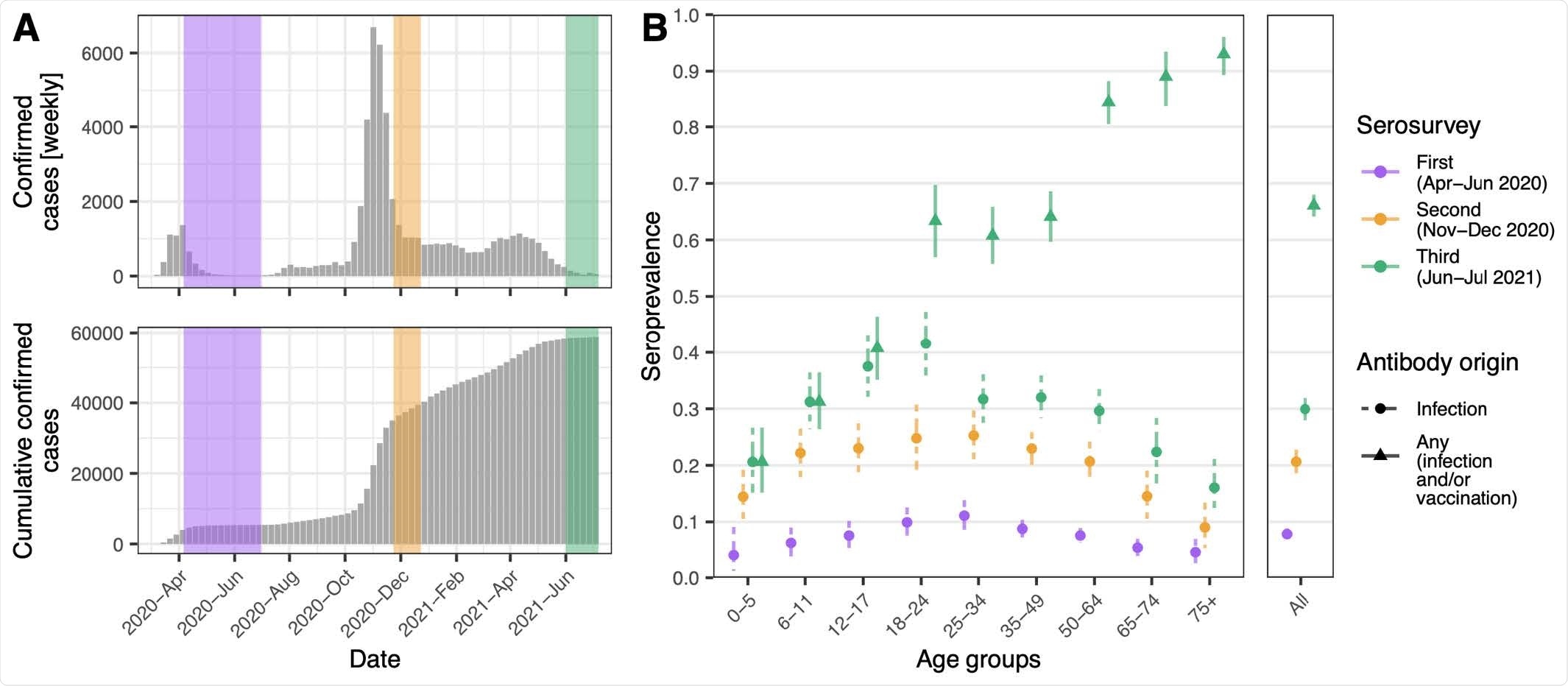
Whether by past infection or vaccination, the level of protection obtained against severe acute respiratory syndrome coronavirus 2 (SARS-CoV-2) within a community can be estimated by seroprevalence studies that compare anti-SARS-CoV-2 antibody levels between individuals.
In a paper uploaded to the medRxiv* preprint server, antibodies against both the spike protein and nucleocapsid proteins of SARS-CoV-2 are measured in over 3,000 volunteers, six months following the initiation of the vaccination scheme in Geneva, Switzerland. The data collected allowed the group to estimate the relative proportions of individuals likely to have achieved immunity by either method, as the vaccine would induce the generation of anti-spike antibodies only, while infection produces a plethora of antibodies.
Geneva has had a moderate COVID-19 burden, with 122 cases per 1,000 inhabitants as of August 2021. Previous studies in the region had indicated that as many as one in ten individuals had developed anti-SARS-CoV-2 antibodies as of summer 2020 before widespread vaccination began.
.jpg)
Seroprevalence within the population
The participants were approximately evenly distributed in gender (54.1% female) and age (20.8% under 18, and 13.4% over 65), with 43.2% having at least one vaccine dose at least two weeks before sample collection. 64.4% of individuals tested positive for anti-spike antibodies, while 27% tested positive for anti-nucleocapsid antibodies, with seroprevalence estimates of 66.1% overall and 29.9% from past infection. Seroprevalence was similar between the sexes.
However, a significant disparity was seen between ages, as older adults had a higher seroprevalence rate of 93.1%, while only 20.8% of children aged 0-5 years exhibited anti-SARS-CoV-2 antibodies. When considering antibodies generated by infection, the lowest seroprevalence rate was amongst older adults aged over 75, presumably as these were the first to be vaccinated. The highest rate of past infection was amongst young adults aged 18-24 years.
The group also tracked seroprevalence amongst demographics based on education level, noting that 59.5% of participants aged over 18 were of tertiary level education and 8.1% primary. Amongst the former group, 58.6% reported having received a COVID-19 vaccine. While for the latter group, the figure for COVID-19 vaccination was 49.3%. Potentially reflecting the anti-spike antibody levels detected amongst the participants, with 75.7% of the tertiary level group and 66.5% of the primary level group testing positive, and also in the number of infections likely incurred by the groups, with 25.4 and 26.1% testing positive for nucleocapsid antibodies, respectively. The overall seroprevalence between them was slightly higher within the tertiary level group, though the number by infection was similar.

The influence of vaccination
The group found that almost three times as many individuals had been infected with SARS-CoV-2 by August 2021 than had been infected by summer 2020, according to reported seroprevalence levels at the time. Young adults and teenagers contributed a large portion to the observed rise. The rates of infection amongst young children and older adults rose comparatively little in this period, reflecting the reported lower risk amongst young children and the administration of vaccines in these groups, respectively.
This study demonstrates the influence of vaccination schemes on protecting the most vulnerable, as groups targeted for vaccination have seen greatly slowed infection rates. The growing disparity between socioeconomic groups in terms of vaccine distribution is also highlighted in this study, though in microcosm compared with global disparity given Geneva's overall relatively wealthy population on a global scale. The authors also call attention to the fact that most younger adults, teenagers, and children lack anti-SARS-CoV-2 antibodies entirely, having not yet been infected or vaccinated, potentially providing a reservoir of individuals within which SARS-CoV-2 has the chance to mutate.
*Important notice
medRxiv publishes preliminary scientific reports that are not peer-reviewed and, therefore, should not be regarded as conclusive, guide clinical practice/health-related behavior, or treated as established information.
- Stringhini, S. et al. (2021) "Seroprevalence of anti-SARS-CoV-2 antibodies six months into the vaccination campaign in Geneva, Switzerland". medRxiv preprint server. doi: https://doi.org/10.1101/2021.08.12.21261929, https://www.medrxiv.org/content/10.1101/2021.08.12.21261929v1.
Posted in: Medical Science News | Medical Research News | Disease/Infection News
Tags: Antibodies, Antibody, Children, Coronavirus, Coronavirus Disease COVID-19, Education, immunity, Protein, Respiratory, SARS, SARS-CoV-2, Serology, Severe Acute Respiratory, Severe Acute Respiratory Syndrome, Spike Protein, Syndrome, Vaccine

Written by
Michael Greenwood
Michael graduated from Manchester Metropolitan University with a B.Sc. in Chemistry in 2014, where he majored in organic, inorganic, physical and analytical chemistry. He is currently completing a Ph.D. on the design and production of gold nanoparticles able to act as multimodal anticancer agents, being both drug delivery platforms and radiation dose enhancers.
Source: Read Full Article